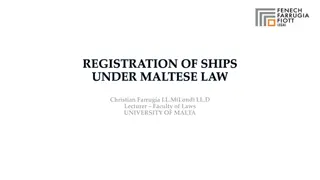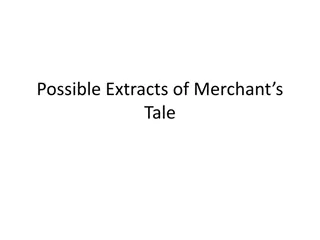Revision of Guidelines for Water Quality on Merchant Ships and Vessels
The revision of guidelines for water quality on board merchant ships, including passenger vessels, is crucial to comply with international health regulations and ensure safety. The aim is to align with WHO, ILO, and MCA requirements, cover gastrointestinal and respiratory organisms, and address challenges in meeting EU directives. Criteria from the EU Drinking Water Directive and WHO guidelines are highlighted, emphasizing the importance of monitoring, testing, and maintaining water quality standards to safeguard public health.
Download Presentation

Please find below an Image/Link to download the presentation.
The content on the website is provided AS IS for your information and personal use only. It may not be sold, licensed, or shared on other websites without obtaining consent from the author. Download presentation by click this link. If you encounter any issues during the download, it is possible that the publisher has removed the file from their server.
E N D
Presentation Transcript
PHE Revision of Ships Waters Guidance Allan Johnson Out posted Scientist PHE, FWEM, Colindale Allan.johnson@phe.gov.uk
Why Revise Guidelines For Water Quality On Board Merchant Ships Including Passenger Vessels- published 2003 Since which- International Health Regulations (2005) Ship sanitation certificate mandatory from 2007 EU -ShipSan Project Started 2013 MGN 525- Guidelines for the provision of Food and Fresh Water 2015
Need to be consistent With requirements of:- WHO ILO MCA
Aim of review Ensure that the guidance is not in contradiction of international and EU guidance. Is relevant to all vessels, including those outside the scope of regulations and other guidance i.e. Commercial Inland vessels and craft under 24 metres Ensure that gastrointestinal and respiratory organisms are covered
Challenges Micro criteria What criteria is relevent? EU Directive? Aimed at mains water supply not stored water
EU Drinking Water Directive Criteria Annex 1 ANNEX I PARAMETERS AND PARAMETRIC VALUES PART A Part A Parameters and Parametric values Microbiological Parameters Parameter Parametric value (number/100 ml) Escherichia coli (E. coli) 0 Enterococci 0 The following applies to water offered for sale in bottles or containers: Escherichia coli (E. coli) 0/250 ml Enterococci 0/250 ml Pseudomonas aeruginosa 0/250 ml (If source influenced by surface waters) Colony count 22 C 100/ml Colony count 37 C 20/ml
Bottled Water Regs Criteria quantitative determination of the indicators of faecal contamination, showing absence of: Escherichia coli and other coliforms in 250 ml; Faecal streptococci in 250 ml; Sporulated sulphite-reducing anaerobes in 50 ml; and Pseudomonas aeruginosa in 250 ml. determination of total viable colony count per millilitre of water at 20-22 C in 72 hours and at 37 C in 24 hours No higher than source load
WHO Guidelines Total coliforms 0/100ml E. coli 0/100ml Intestinal Enterococci 0/100 ml C. perfringens 0/100 ml HPC (ACC) No parameters but suggests 2 samples and looking at any differences P. aeruginosa Mentioned but no parameters Legionella - Mentioned but no parameters
ShipSan E. coli 0/100ml Coliforms 0/100ml Enterococci 0/100ml C. perfringens 0/100ml ACC 22 C No abnormal change
Legionella- Hot and Cold systems/Hot tubs HSE/PHE Guidance < 100cfu/1000ml No action needed >100cfu - <1000cfu/1000ml Resample and review controls >1000cfu/1000ml immediate high level disinfection review of controls High proportion (>20% ve+ indicates colonisation, review controls, high level disinfection
Legionella ShipSan (Based on EWGLI Criteria) Hot and cold Systems < 1000 Under control >1000 - >10,000- If small proportion 10%-20% ve+ resample >20% resample, review and disinfect >10,000 Immediate review and disinfection Hot Tubs - >100 close pool, drain, clean and disinfect keep closed until no positives 10 days
Which one? Decision will be made by PHE in discussion with PHA s
Non EU regs and guidance China Include bacillus spp. Other countries?
Proposed Lay out Basic requirements and parameters Unlikely to change much fro existing but probably loosing ACC s Additional sections to cover technical details of systems. Will cover all fresh water systems including non potable such as recreational waters.
Additions Hot and cold system Source Shore, barge, on board production and others Storage Disinfection Cl, ClO2, Ag, UV etc Distribution number of systems Recreational Pools, Hot tubs and fountains Some technical waters Screen wash, laundry,
What and where Each section will have explanation of the key components, what they look like, what they do, what to check. Common faults/problems and suggestions on corrective measures It will not be another handbook for inspection but a technical reference to assist inspection using WHO/ ShipSan manuals
Trail The intention is after production of draft to test drive it PHO s with experience PHO s with little experience Students with no experience If it works first time .
Source Potable water can be bunkered by a number of means: Shore supply. In EU countries the quality of potable water must conform to the European Water Directive which set out microbiological criteria of absence of E.coli, coliforms and Enterococci, in addition it sets limits for ACC s (Aerobic Colony Count) however, as these standards are set for mains piped supply and not water from storage tanks therefore it is not considered that ACC s should be tested for in ships waters as, particularly on cruise ships large volumes are stored sometimes for extended periods and so ACC s are likely to be present. The exception to this would be in circumstances where water is tested on a weekly basis where ACC s could be a useful indicator when used to show trends. Ships should request evidence, by means of a recent laboratory report, from the port, or in the case of inland vessels the owner of the dock or berth, of bunkering prior to accepting water. In the absence of a recent satisfactory report bunkering should be declined or the supply chlorinated at the higher level during and after bunkering to ensure quality. The ship should record the port of bunkering, date and time of commencement of bunkering, the quantity taken in m3 or tonnes, the date and time of bunkering completion in the ships log or a log for this specific activity.
Desalination Fresh water Evaporation This process involves sea water being taken into sea chests positioned well below the water line typically at the bow, in any case they should be well in front of any overboard outlets from sewage, oily water separators etc. They are fitted with a coarse screen to prevent large debris entering the tank. The sea water is then transferred to various systems in the vessel including the fresh water evaporator. Water will boil at 100 C but by applying a partial vacuum in the evaporator it will reduce this to 60 C -70 C. The raw water is drawn into the evaporator, it will be passed over steam pipes which will heat the water, the steam created will rise and make contact with the condenser plate (Demister) which will cool the water and cause any with salts to drop into the sump, the distillate will then be piped over the incoming raw sea water to cool it further before being pumped to the fresh water tanks. The water to the tank will be passed through a salinity meter, the WHO do not set maximum limits for Sodium in water but recommend >200mg/l, most salinity meters are set to monitor in seimens a measure of conductivity and should be set to a level of between 0-22, where its is detected that this is exceeded an alarm should sound in the engine control room and a valve open to dump the produced water to sea. The heavy saline water left at the base of the evaporator will be returned to sea.
Seawater feed 2. Heating medium in 3. Heating medium out 4. Seawater cooling in 5. Seawater cooling out 6. Fresh water out 7. Evaporated steam 8. Demister 9. Condenser 10. Evaporator 11. Brine out
On large vessels such as cruise ships they may use flash evaporators






















